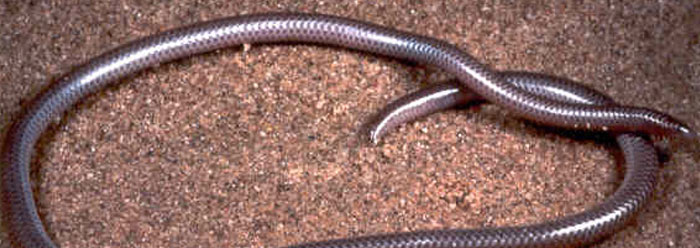The blindsnake, a small subsurface burrower, is not often seen, but when it is many mistake it for a worm.1 Researchers have constructed an evolutionary history for these creatures, partly from biological data and partly from evolutionary assumptions. But if events occurred as these scientists suggest, then blindsnakes must have made fantastic voyages across vast oceans to reach their current habitats.
In a study published online in the Royal Society's Biology Letters, researchers from Pennsylvania State University and other institutions burrowed into DNA sequence data from five genes found in 96 different species of blindsnakes in order to establish evolutionary relationships between the species.2 They used molecular clocks--which are far from objective and yield inherently biased results3--to decide when one group split from another.
The gene differences were all assumed to have been caused by mutation, and the gene data was fitted into an algorithm that presumed that all the blindsnakes shared a common ancestor. The study’s results presented a significant problem. When the dates assigned to the species' divergence are compared to the prevailing theories of continental drift, certain families of blindsnakes must have developed after the combined land mass of Madagascar and India (dubbed "Indigascar" by the researchers) broke away from East Gondwana, which had earlier split from Gondwana, an ancient supercontinent.
A Penn State press release stated the problem succinctly: If the earliest blindsnake lineages developed on Indigascar, as the Biology Letters study claims, "how did they get to all of those other places in the world that they occupy today--Europe, Asia, Australia, Africa, and the Americas?" They infrequently venture up to the earth's surface and are not known to swim at all. The press release stated that the researchers' results led them to conclude that blindsnakes distributed themselves across the globe on "flotsam":
The period of greatest diversification coincided with a time of low sea levels, when connections between continents were forming and the dispersal of such unlikely animals by floating on flotsam was easier.4
Thus, one blindsnake family supposedly repeatedly floated and burrowed all the way from Africa to Australia, and another somehow floated for about six months across the Atlantic Ocean to reach the Americas! Senior researcher Blair Hedges said, "Some scientists have argued that oceanic dispersal is an unlikely way for burrowing organisms to become distributed around the world….Our data now reinforce the message that such 'unlikely' events nonetheless happened in evolutionary history."4
But since such transcontinental events are not observed today, the floating flotsam theory flounders. Slow and gradual processes mainly remove silt from continents, and they would not explain this dispersal nearly as well as a worldwide catastrophe that forced floating forest mats across whole oceans in earth's recent past.5
Because of the incongruity between the speculative dates of continental breakup and the speculative dates of snake divergence, it is likely that the assigned evolutionary ages for these snakes--or for any other organism similarly dated, for that matter--are anything but trustworthy.
References
- Although they are called blindsnakes, most can detect light.
- Vidal, N. et al. Blindsnake evolutionary tree reveals long history on Gondwana. Biology Letters. Published online before print March 31, 2010.
- For example, see Thomas, B. Frozen Penguin DNA Casts Doubt on DNA-Based Dates. ICR News. Posted on icr.org November 25, 2009, accessed April 9, 2010.
- Ancient snakes living on Madagascar. Penn State University Press release, March 30, 2010.
- Morris, J. 1999. The Polystrate Trees and Coal Seams of Joggins Fossil Cliffs. Acts & Facts. 28 (10).
* Mr. Thomas is Science Writer at the Institute for Creation Research.
Article posted on April 22, 2010.
























